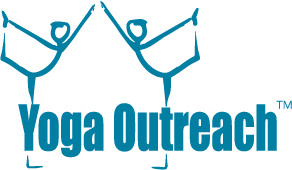Your stomach hurts. Your neck and shoulders have hardened to concrete. Your vision and hearing are stuttering. You feel dizzy. Your mind is hunting for dangers, for solutions, for something … you’re not sure what.This might be how you feel when your body becomes dysregulated or overwhelmed. It’s definitely a feeling familiar to yoga students at Pacifica Treatment Centre, an addiction recovery residence where our volunteers 4 weekly teach trauma-informed classes.
Usually this means you’re worrying so much about events in the future or replaying events in the past, that you aren’t even aware of the present – except for those horrible physical symptoms, of course.
Strangely, an incredibly effective way to tune back in to the present is by paying more attention to the body. Your body, even tense, pained or hyperventilating, only exists in the present. And since your body is always with you, it’s the perfect tool for reeling your anxious mind back from the brink of overwhelm.
Following is a grounding exercise that students in our yoga classes find helpful for coping with panic attacks and anxiety.
Grounding Exercise – Noticing the Body
Find a comfortable way to sit. [You can also try this exercise standing or sitting]
Step 1 – Recognizing your Body
Notice your body. You may be uncomfortable, cold, hot, or tense. You may have pain in some places, say your neck, or your feet. That’s okay. Noticing what isn’t comfortable is as valuable as noticing what is. Move on to parts of your body that are more comfortable or neutral. If that isn’t possible, you might notice whether the discomfort ebbs and flows, or is constant.
If it’s useful, shift left or right, or forward and back a little. Notice which parts of your body are in contact with the ground.
Take three breaths or more while paying attention only to your body. When worrisome thoughts pop up, tell yourself that you will deal with those later. For a few minutes you are paying attention only to your body.
Step 2 – Centring
Bring your attention to the centre of your body, wherever that is for you. That might be your chest, belly, or head. Or maybe you don’t notice a centre today. Either is okay, and interesting for your mind to notice.
If useful, pull your stomach muscles in as you breathe out. This expels more residual air and may help to lengthen your out breath.
Why this works: When we exhale, particularly when the exhale is longer than the inhale, we trigger the parasympathetic nervous system. After a few minutes of slower exhales, our breathing pattern tells the heart to slow down. (Conversely, extending your inhale would encourage the heart to speed up.
Take three breaths, imagining the air flowing through your centre, wherever that is.
Step 3 – Connections within your body
Bring your attention around to your low back. Notice how your spine leads up from your sitting bones, connecting to your ribcage, your shoulders and collarbones. Or you may instead focus on the muscles in your back. Are they tense or relaxed? Can you feel your muscles, ribs or chest moving as you breathe in or out?
Take three breaths, noticing which parts of your body move with your breath.
Step 4 – Posture
Try lengthening your spine by sitting up tall and lifting the crown of your head closer to the ceiling. While sitting up tall, you might also see how it feels to bring your shoulders down from your ears and down your back. Perhaps you can also relax your hips or thigh muscles. Imagine pushing your sitting bones farther away from the crown of your head.
Take a few more breaths, thinking about lengthening your spine or releasing your muscles. Or stay as long as you like, noticing any aspect of your breath or body you like.
Why this works: Noticing the physical sensation of the ground – hard, cold, comfortable, etc. – is a tool for making our minds aware of the present moment. When we have to assess the current state of our bodies, whether they are alert, slouched or in pain, we temporarily interrupt our internal dialogue. It is a way of anchoring our thoughts to one spot – our body – so that they don’t spiral into unnecessary storms.
Even more ideas for grounding
This muscle-relaxing audio-recording is suitable for all ages.
What to do when you or a loved one has a panic attack or flashback.
Mindful breathing isn’t the only way to fend off a panic attack. Here are more ways to re-focus using your five senses.
